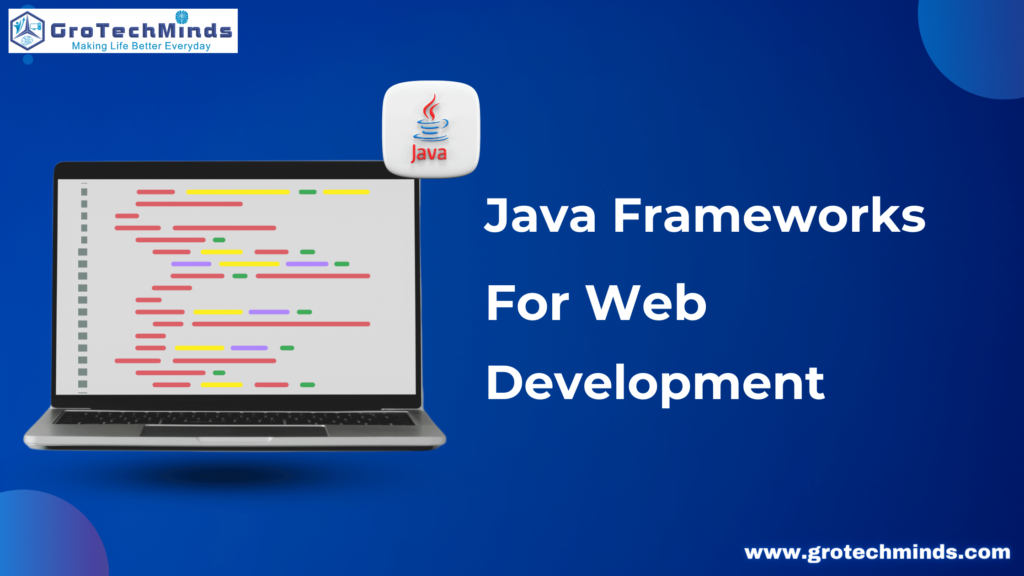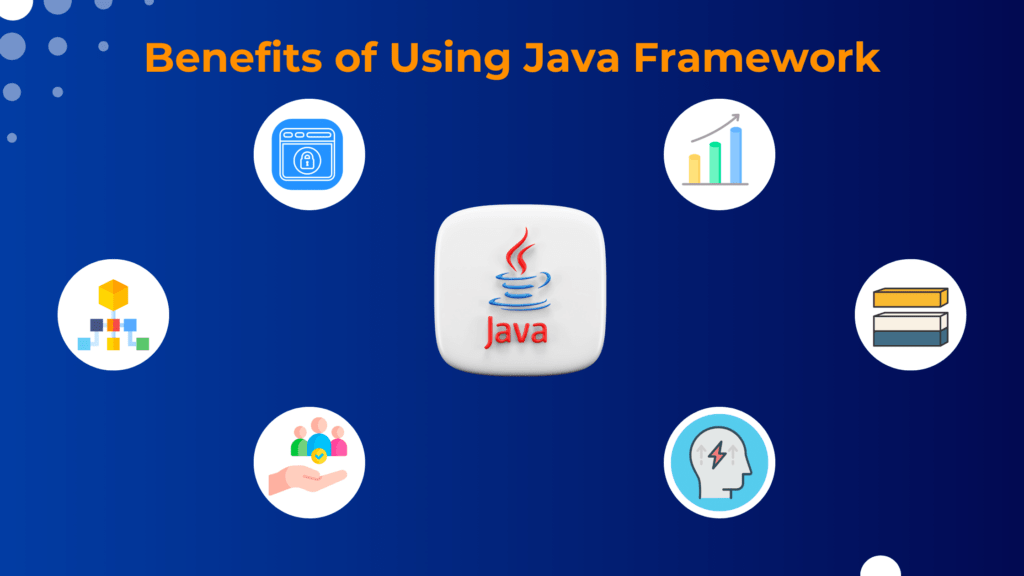

Java Frameworks for Web Development
Frameworks serve as key tools in the fast-paced world of Java programming, reducing the development process and helping developers to create complex apps smoothly. One standout is the Spring Framework, a flexible master who simplifies everything from web application development to data access. Its novel features, like dependency injection and aspect-oriented programming, are a breath of fresh air in Java development, making it a dependable part for those seeking flexibility and efficiency.
A Java framework is an established and usable structure that serves as the base for developing applications. Essentially, it is a collection of pre-written code and principles that developers may use to speed up the development process and save time and effort. Java frameworks provide an organised approach to application development by defining the general construction, organising code, and providing a collection of tools and libraries for common tasks.
These frameworks serve as scaffolding, providing an established foundation for developers to build on while focusing on the individual features and functionalities of their applications. Java frameworks are intended to cover a variety of areas of software development, including web application development, database interaction, and user interface design. They promote best practices, design patterns, and coding conventions, which guarantees project consistency and facilitates developer collaboration.
a Java framework is a useful tool for developers, providing a well-organised and standardised approach to developing software applications. It simplifies the development process, encourages code reuse, and makes it easier to build powerful, scalable, and maintainable applications.
Java frameworks are useful resources that make website development easier and faster. They offer pre-built sets of rules and tools, making the more difficult elements of website development easier. These frameworks, such as Spring or JavaServer Faces, assist developers by providing a clear structure for following and managing typical activities. This allows developers to focus on adding unique features to their websites while spending less time on repetitive or difficult coding.
Java frameworks also provide benefits such as increasing website security, assisting with scalability (handling more users), and allowing developers to reuse code, similar to using building blocks for different parts of a site. With a large community of support and extensive documentation, Java frameworks make the web development process easier, allowing developers to design websites that are not only efficient but also easier to manage and grow over time.

Benefits of Using Java Framework
The main benefit is the increase in productivity that Java frameworks give. This advantage is essential since it saves developers time and effort by leveraging pre-built modules and conventions, allowing them to focus on developing unique features for their applications.
Scalability is key to the success of web applications, therefore it must be prioritised. Java frameworks, which include features such as connection pooling and caching methods, guarantee that programs can handle increasing workloads and user bases while maintaining performance.
Protecting the security of online applications is important. Java frameworks with built-in security features assist developers in implementing and maintaining secure coding standards, hence protecting applications from typical security vulnerabilities.
A well-organised and uniform code is critical for maintainability and cooperation. Java frameworks, such as Spring, promote disciplined coding practices and design patterns, which improves code readability and ease of maintenance.
The modular approach provided by Java frameworks is critical for code reuse and maintainability. Breaking down apps into manageable parts allows developers to update and maintain individual pieces, improving overall application stability.
Active communities share resources and information, assisting developers in overcoming challenges and staying current on best practices. While essential, it may not have the same immediate impact on the development process as other components do.

Popular Java Frameworks
Spring is a broad and modular Java framework for developing strong and scalable enterprise applications. It simplifies Java development by offering solutions for dependency injection, aspect-oriented programming, and a variety of other features.
- Dependency Injection
- Aspect-Oriented Programming
- Spring MVC
- Spring Boot
- Provides a non-intrusive method to development.
- Promotes clear, maintainable code.
- Has a huge and active community, which ensures ongoing support and upgrades.
Hibernate is a Java object-relational mapping (ORM) framework that connects a Java program to a relational database. It simplifies database interactions by allowing developers to use Java objects rather than SQL queries.
- Mapping
- Lazy Loading
- Caching
- Query Language (HQL)
- Reduces the need for manual SQL queries, which increases developer efficiency.
- Improves code mobility by making the program database-agnostic.
- Improves application performance by efficiently managing database activities.
Java Server Faces is a Java web application framework that facilitates the creation of user interfaces for Java EE applications. It has reusable user interface elements and a strong event-driven programming approach.
- Component-Based
- Managed Beans
- Ajax Support
- Integration
- Reusable components help to speed up UI development.
- Provides a common approach to developing web apps in Java.
- Supports easy integration with a variety of Java EE technologies.
Apache Struts is an open-source framework for building Java EE web applications. It uses the Model-View-Controller (MVC) design, which separates the presentation layer, business logic, and data access.
- MVC Architecture
- Action-Based Framework
- Form Validation
- Tag Libraries
- The convention-over-configuration method promotes quick development.
- The MVC architecture promotes code reuse and maintenance.
- Integrates smoothly with other Java technologies, like Hibernate and Spring.
Play Framework is a Java and Scala web framework that is both lightweight and high-performance. It employs a reactive programming style, emphasising simplicity and developer efficiency.
- Hot Reloading
- Asynchronous I/O
- RESTful APIs
- Template Engine
Accelerates development with its intuitive APIs and built-in features.
Allows the development of extremely scalable and responsive web applications.
Provides an easy interface with common Java libraries and frameworks.
Blade is a lightweight, elegant web framework for Kotlin and Java that prioritises simplicity and efficiency. It has a basic API and follows the idea of convention over configuration, making it appropriate for developing small to medium-sized web applications.
- Minimalistic Design
- Modular Architecture
- Annotation-Based Routing
- Template Engine Integration
- The basic and straightforward approach facilitates web application development.
- The convention over configuration attitude promotes fast prototype and iteration.
- Provides flexibility and extensibility via its modular design and plugin system.
Google Web Toolkit (GWT) is a Java development toolkit that helps you design and optimise complex browser-based applications. It allows developers to create client-side code in Java, which is afterwards compiled into highly efficient JavaScript that is compatible with all major browsers.
- Java-to-JavaScript Compilation
- Rich Set of Widgets
- Remote Procedure Calls
- Development Mode
- Allows developers to use their Java abilities to create powerful web applications.
- simplifies development by providing an extensive collection of tools and libraries for designing advanced user interfaces.
- Improves productivity and user experience through efficient Java-to-JavaScript translation and browser compatibility.
Dropwizard is a Java framework for developing portable, production-ready microservices and web applications. It incorporates well-known libraries like Jersey, Jackson, and Jetty into a single package for quick development.
- Integrated Components
- Operational Features
- Convention over Configuration
- Extensibility
- Its interconnected components and simplified approach allow for the speedy creation of microservices and web applications.
- Simplifies operational duties such as monitoring and configuration, leading in increased developer productivity.
- Provides a strong, battle-tested framework for developing powerful and stable applications.
Vaadin is an open-source web application framework that allows you to create advanced, interactive Java user interfaces. It includes a full set of modules and tools for developing modern web apps without requiring JavaScript or HTML knowledge.
- Component-Based Development
- Data Binding
- Event-Driven Programming
- Server-Side Rendering
- Allows Java developers to create modern web apps with rich, interactive user interfaces.
- Reduces development time and cost by introducing a high-level overlay of client-side technology.
- Supports cross-browser integration and accessibility, resulting in a consistent user experience across devices and platforms.
Wicket is a Java web application framework that focuses on component reuse and object-oriented design principles. It offers a diverse range of components and a clear separation of concerns, allowing developers to create scalable and maintainable online applications.
- Component-Based Development
- POJO Model
- Event-Driven Programming
- Integration with Java EE
- With its component-based technique and a wealth of reusable components, it allows for rapid development.
- Promotes code clarity and upkeep by using strong separation of concerns and object-oriented architecture.
- The POJO framework and easy-to-mock components facilitate test-driven development
In conclusion, Java frameworks are important in web development because they help projects organise, scale, and be more efficient. The benefits of adopting Java frameworks are numerous, including faster development times, higher code quality, and simpler maintenance. By exploring popular frameworks such as Spring, Hibernate, and Struts, developers may leverage Java’s capabilities to create robust and dynamic web applications. Whether you’re an experienced developer or just getting started, including Java frameworks into your workflow can greatly increase your productivity and project success. Continue to research Java frameworks to keep current in the ever-changing world of web development.
Also, Automation Testing Course with Java frameworks are powerful and effective techniques to assure the quality and performance of software applications. Using popular Java testing frameworks like JUnit, TestNG, and Selenium, developers and quality assurance experts may design strong test suites and automate repetitive testing processes. With Java frameworks’ flexibility and scalability, teams can expedite testing processes, boost test coverage, and ultimately provide high-quality software to end users.
Consult Us


















